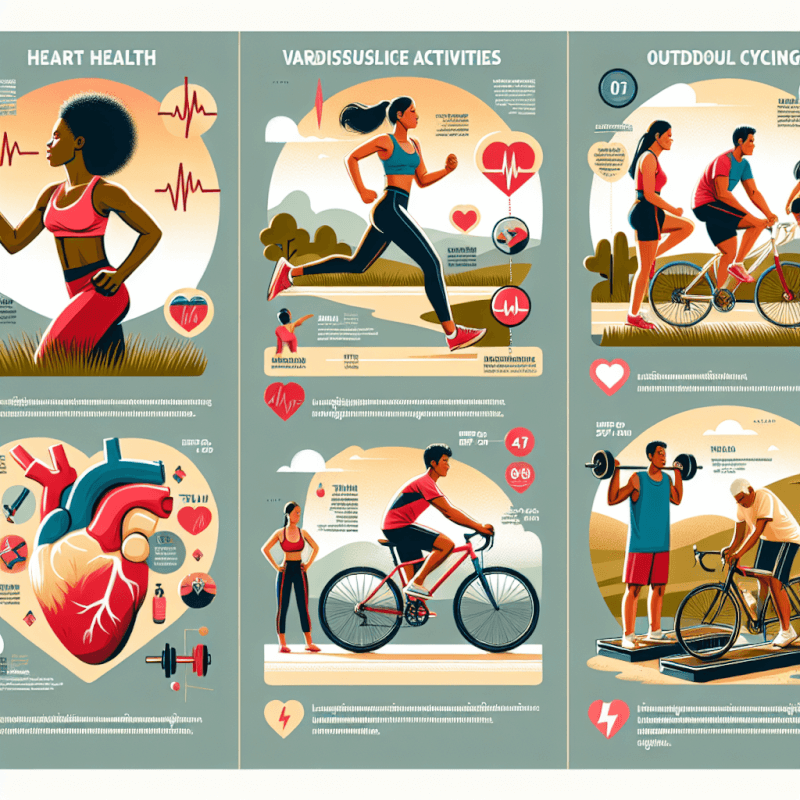When it comes to taking care of your heart, exercise plays a crucial role. But with countless options out there, it can be overwhelming to know which types of exercise yield the best results. In this article, we’ll explore the best exercises for improving heart health. So whether you prefer running on the treadmill or dancing in your living room, read on to discover the most effective ways to keep your heart pumping strong and healthy.
Aerobic exercises
Definition and benefits of aerobic exercises
Aerobic exercises, also known as cardiovascular exercises, are activities that increase your heart rate and breathing for a sustained period. These exercises work your large muscle groups, such as your legs and arms, and get your heart pumping to deliver oxygen-rich blood to your muscles. The benefits of aerobic exercises extend beyond just improving heart health. They can also help in weight management, reduce the risk of chronic diseases like diabetes and high blood pressure, boost mood and mental well-being, and increase overall stamina and endurance.
Regular aerobic exercise can lower your heart rate at rest and during exercise, improve your body’s ability to use oxygen, and reduce your blood pressure. It can also increase your HDL (good) cholesterol levels and decrease unhealthy triglyceride levels, consequently reducing the risk of heart disease. Aerobic exercises also promote the release of endorphins, which are natural mood elevators that can help reduce symptoms of depression and anxiety.
Examples of aerobic exercises
There are numerous aerobic exercises to choose from, ensuring that you can find an activity that suits your preferences and fitness level. Some popular aerobic exercises include:
Walking: It is a low-impact exercise that can be easily incorporated into your daily routine. Walking briskly for at least 30 minutes a day can offer significant health benefits.
Running and jogging: These high-impact exercises increase your heart rate and provide a great cardiovascular workout. Start with a comfortable pace and gradually increase the intensity and duration to avoid injury.
Cycling: Whether you prefer indoor cycling on a stationary bike or outdoor biking, cycling is a fantastic aerobic exercise that strengthens your heart and leg muscles.
Swimming: This low-impact exercise is gentle on the joints and provides a full-body workout. Swimming laps or participating in water aerobics classes can be excellent options for improving heart health.
Dancing: Dancing is a fun and energetic way to get your heart pumping. From salsa to hip-hop, there are various dance styles to choose from that cater to different fitness levels.
Jumping rope: This simple and affordable exercise can be done anywhere, and it effectively elevates your heart rate. Start with shorter intervals and gradually increase the duration as your fitness improves.
Aerobic classes: Joining group classes like Zumba, step aerobics, or kickboxing can provide a social atmosphere while improving your cardiovascular fitness.
Strength training
Definition and benefits of strength training
Strength training, also known as resistance training or weightlifting, involves using resistance to build strength, endurance, and muscle mass. While it may not seem directly related to heart health, strength training plays a crucial role in maintaining overall cardiovascular fitness. It increases your muscle mass, which helps improve metabolism and aids in weight management. Additionally, strength training strengthens the muscles surrounding your heart, allowing it to work more efficiently.
Regular strength training can reduce the risk of heart disease by improving cardiac function, lowering blood pressure, and decreasing unhealthy cholesterol levels. It also helps improve insulin sensitivity and manage blood sugar levels, reducing the risk of developing type 2 diabetes. Strength training can enhance bone density, reducing the risk of osteoporosis, and improve overall balance and stability, reducing the chances of falls and fractures.
Examples of strength training exercises
Strength training exercises involve using resistance, such as dumbbells, resistance bands, or bodyweight, to challenge your muscles. Here are some examples of strength training exercises that can benefit heart health:
Squats: This compound exercise targets multiple muscle groups, primarily the quadriceps, hamstrings, and glutes. Squats can be performed with just your bodyweight or added resistance, such as holding dumbbells.
Lunges: Similar to squats, lunges strengthen the lower body muscles, including the quadriceps, hamstrings, and glutes. They can be performed stationary or walking, and variations like reverse lunges or side lunges can engage different muscle groups.
Push-ups: This classic exercise targets your chest, shoulders, triceps, and core muscles. It can be modified based on fitness level, starting from wall push-ups or progressing to full push-ups.
Planks: Planks are great for strengthening the core muscles, including the abdominals, obliques, and lower back. Holding a plank position engages multiple muscle groups simultaneously.
Deadlifts: Deadlifts primarily work the muscles of the posterior chain, including the hamstrings, glutes, and lower back. They can be performed with barbells, dumbbells, or kettlebells.
Bench press: This exercise targets the muscles of the chest, shoulders, and triceps. It can be performed using a barbell, dumbbells, or a chest press machine.
Pull-ups or lat pulldowns: These exercises engage the muscles of the back and arms. If unable to do pull-ups, lat pulldowns using a cable machine can provide similar benefits.
Remember to start with light weights and focus on correct form to avoid injury. Gradually increase the weight as your strength improves.

High-intensity interval training (HIIT)
Definition and benefits of HIIT
High-intensity interval training (HIIT) involves alternating between short bursts of intense exercise and periods of active recovery. This type of exercise elevates your heart rate significantly and challenges your cardiovascular system. HIIT workouts are typically shorter in duration compared to traditional aerobic exercises but offer comparable or even superior benefits in terms of heart health and calorie burning.
HIIT offers several benefits for heart health. It improves cardiovascular fitness by strengthening the heart muscle, increasing stroke volume (amount of blood pumped with each beat), and enhancing oxygen delivery to the working muscles. HIIT is also effective in reducing body fat, particularly the dangerous visceral fat that surrounds organs and contributes to heart disease risk.
Additionally, HIIT improves insulin sensitivity and glucose metabolism, which helps regulate blood sugar levels and reduce the risk of developing type 2 diabetes. It also promotes the release of human growth hormone (HGH), which aids in muscle growth, repair, and overall health.
Examples of HIIT exercises
HIIT exercises can be tailored to individual fitness levels and preferences. Here are some examples of HIIT exercises you can incorporate into your routine:
Burpees: Begin in a standing position, then drop into a squat, kick your legs back to perform a push-up, jump your feet back into a squat position, and explosively jump up. Repeat for a set duration or a specific number of repetitions.
Sprint intervals: Find a flat stretch of ground or use a treadmill. Sprint at your maximum effort for a short distance, then rest or walk for an equal or slightly longer duration. Repeat for multiple intervals.
Jumping jacks: Perform jumping jacks at a high intensity for a set duration, followed by a short rest period. Repeat for multiple cycles.
High knees: Stand in place and lift your knees up towards your chest as quickly as possible for a set duration. Alternate between high knee lifts and a brief rest period.
Mountain climbers: Start in a plank position, then alternate driving your knees in towards your chest as fast as possible. Repeat for a specific duration or number of repetitions.
Remember to warm up adequately before attempting HIIT exercises and gradually increase the intensity as your fitness level improves. Consult with a healthcare professional before starting any new exercise routine, especially if you have any underlying health conditions.
Low-impact exercises
Definition and benefits of low-impact exercises
Low-impact exercises are gentle on the joints and provide a cardiovascular workout without putting excessive stress or strain on the body. These exercises are suitable for individuals with joint pain, arthritis, or those who prefer a less intense workout. Low-impact exercises contribute to heart health by improving cardiovascular fitness, reducing the risk of heart disease, and aiding in weight management.
The benefits of low-impact exercises include increased calorie expenditure, improved muscular strength and endurance, enhanced flexibility and joint mobility, and reduced risk of injury. These exercises are also ideal for individuals recovering from an injury or surgery, as they help rebuild strength and gradually restore full range of motion.
Examples of low-impact exercises
Here are some examples of low-impact exercises that can be beneficial for heart health:
Walking: Walking is a gentle exercise that can be easily incorporated into your daily routine. It is a great way to increase your cardiovascular fitness without putting stress on your joints.
Swimming: Swimming is a low-impact exercise that provides a full-body workout. The buoyancy of water reduces stress on the joints, making it ideal for individuals with joint pain or injuries.
Cycling: Whether it’s riding a stationary bike or cycling outdoors, this low-impact exercise strengthens the heart and leg muscles without placing excessive strain on the joints.
Yoga: Yoga combines gentle movements, stretching, and breath control, making it an excellent choice for a low-impact exercise that improves cardiovascular fitness, flexibility, and overall well-being.
Elliptical training: Using an elliptical machine provides a low-impact, full-body workout that elevates your heart rate. It mimics the motion of walking or running but without the impact on your joints.
Pilates: Pilates focuses on core stability, flexibility, and controlled movements. It can be performed on a mat or using specialized equipment, such as a reformer, to provide a low-impact workout that improves posture and strengthens muscles.
Remember to listen to your body and modify exercises based on your fitness level and any preexisting conditions. If you experience any pain or discomfort during exercise, consult with a healthcare professional.

Swimming
Benefits of swimming for heart health
Swimming is often acclaimed as one of the best exercises for overall cardiovascular fitness. It engages the entire body, offering a great cardiovascular workout while being gentle on the joints. Swimming regularly can significantly improve heart health by strengthening the heart muscle and improving circulation.
Swimming provides a low-impact workout that increases heart rate and oxygen consumption, boosting cardiovascular endurance. The water’s resistance helps build muscle strength, including the muscles surrounding the heart, leading to improved cardiac function. Additionally, swimming can lower blood pressure and reduce the risk of heart disease by improving blood lipid profiles and insulin sensitivity.
Swimming also has unique benefits for individuals with respiratory conditions such as asthma or chronic obstructive pulmonary disease (COPD). The moist air in the pool environment can help open up airways and improve respiratory function.
Different swimming strokes and their impact on heart health
Swimming offers a variety of strokes that provide different levels of intensity and work different muscle groups. Here are some common swimming strokes and their impact on heart health:
Freestyle (Front Crawl): Freestyle is the fastest and most efficient swimming stroke. It engages multiple muscle groups, primarily the arms, shoulders, back, and core. The continuous arm and leg movements increase heart rate and provide an excellent cardiovascular workout.
Backstroke: Backstroke allows you to work your entire body while providing a unique cardiovascular challenge. It primarily targets the muscles of the back, shoulders, and glutes. The rhythmic leg and arm movements increase heart rate and help improve flexibility.
Breaststroke: Breaststroke is a slower-paced stroke that focuses on the muscles of the chest, arms, and legs. It can be beneficial for individuals with joint issues as it is gentle on the knees. Breaststroke offers a moderate cardiovascular workout and provides an opportunity for controlled breathing.
Butterfly: Butterfly is the most challenging swimming stroke, requiring significant upper body strength and coordination. It engages the muscles of the chest, shoulders, back, and core. Butterfly provides an intense cardiovascular workout and can greatly improve overall strength and power.
To maximize the cardiovascular benefits of swimming, aim to swim for at least 30 minutes, three to five times per week. Varying between different strokes can help target different muscle groups and provide a well-rounded workout.
Cycling
Benefits of cycling for heart health
Cycling is a versatile and enjoyable activity that offers numerous benefits for heart health. Whether you choose outdoor cycling or indoor cycling on a stationary bike, this low-impact exercise can effectively strengthen your heart and improve cardiovascular fitness.
Cycling is an aerobic exercise that elevates your heart rate, increasing blood flow and oxygen delivery to your muscles. Regular cycling can lower your resting heart rate, making your heart more efficient at pumping blood. It also stimulates the production of nitric oxide, a molecule that helps dilate blood vessels, resulting in improved blood flow and reduced blood pressure.
Cycling is also beneficial for weight management and reducing the risk of heart disease. It burns calories, increases metabolism, and helps maintain a healthy body weight. Additionally, it reduces LDL (bad) cholesterol levels and increases HDL (good) cholesterol levels, minimizing the buildup of plaque in the arteries and reducing the risk of heart attacks and strokes.
Types of cycling exercises for improving heart health
Cycling offers a variety of options to suit different fitness levels, preferences, and outdoor conditions. Here are some types of cycling exercises that can improve heart health:
Leisure cycling: Take leisurely rides on flat or gently rolling terrain, enjoying the scenery while keeping a moderate pace. This is an excellent starting point for beginners or individuals looking for a less intense workout.
Road cycling: Hit the roads and challenge yourself with longer distances, hills, and varied terrains. Road cycling offers a great cardiovascular workout and allows you to explore different routes and destinations.
Indoor cycling: Join a spin class or use a stationary bike at home or the gym. Indoor cycling classes often incorporate intervals, hills, and sprints, providing an intense cardiovascular workout. The adjustable resistance allows you to tailor the workout to your fitness level.
Mountain biking: For those seeking a more adventurous and challenging workout, mountain biking offers a great cardiovascular and full-body workout. The rugged terrain and elevation changes provide additional resistance, engaging various muscle groups.
Commuting by bicycle: Incorporate cycling into your daily routine by biking to work or running errands. This not only improves heart health but also reduces carbon emissions and promotes a more active lifestyle.
Remember to wear appropriate safety gear, including a helmet, and follow traffic rules when cycling outdoors. If using a stationary bike, adjust the seat height and handlebar position to ensure proper form and minimize the risk of injury.

Running and jogging
Benefits of running and jogging for heart health
Running and jogging are excellent aerobic exercises that offer various benefits for heart health. These high-impact activities increase heart rate, oxygen consumption, and overall cardiovascular fitness. Regular running or jogging can improve heart function, decrease blood pressure, and lower the risk of heart disease.
Running and jogging stimulate the heart to pump blood more efficiently, strengthening the heart muscle and improving its ability to deliver oxygen to the body. It increases coronary blood flow, which can reduce the risk of heart attacks and improve overall cardiovascular health. Additionally, running and jogging can lead to weight loss or weight maintenance, reducing the risk of obesity and associated heart conditions.
Engaging in consistent running or jogging can improve lipid profiles by increasing HDL (good) cholesterol levels and decreasing LDL (bad) cholesterol levels and triglycerides. This helps to prevent the buildup of plaque in the arteries and lowers the risk of heart disease. Running and jogging have also been shown to improve insulin sensitivity, aiding in blood sugar regulation and reducing the risk of developing type 2 diabetes.
Tips for safe running and jogging
To ensure a safe and enjoyable running or jogging experience, consider the following tips:
Proper warm-up: Start with a dynamic warm-up that includes dynamic stretches and light cardio exercises to prepare your muscles and joints for the activity. This can help reduce the risk of injury.
Gradual progress: Begin with shorter distances and slower paces, gradually increasing the duration and intensity of your runs or jogs. This allows your body to adapt to the demands of running and reduces the risk of overuse injuries.
Appropriate footwear: Invest in a good pair of running shoes that provide proper support and cushioning. A running specialty store can help you find the right shoes for your foot type and running style.
Listen to your body: Pay attention to any pain, discomfort, or fatigue during your runs or jogs. Give yourself adequate rest and recovery days to prevent overtraining and injury. If you experience persistent pain or symptoms, consult with a healthcare professional.
Hydration and nutrition: Stay hydrated before, during, and after your runs or jogs, especially in hot weather. Fuel your body with nutritious foods to provide the energy and nutrients it needs for optimal performance and recovery.
Vary your routes: Explore different running routes to keep your workouts interesting and engage different muscle groups. Consider incorporating trail running for the added challenge and scenic views.
Remember to consult with a healthcare professional before starting a running or jogging program, especially if you have any underlying health conditions or joint issues.
Walking
Benefits of walking for heart health
Walking is a simple yet highly effective exercise for improving heart health. It is accessible to people of all ages and fitness levels, making it an excellent choice for individuals who are just starting their fitness journey or those with existing health conditions. Regular walking can have significant cardiovascular benefits and improve overall well-being.
Walking is an aerobic exercise that raises your heart rate, strengthens your heart muscle, and improves circulation. It helps reduce blood pressure and lowers the risk of heart disease. Walking regularly can also contribute to weight management by burning calories and increasing metabolism.
Studies have shown that walking can improve lipid profiles by increasing HDL (good) cholesterol levels and reducing LDL (bad) cholesterol levels and triglycerides. This helps reduce the risk of plaque buildup in the arteries and decreases the likelihood of cardiovascular events. Walking also improves insulin sensitivity, which helps regulate blood sugar levels and reduces the risk of developing type 2 diabetes.
Incorporating walking into a daily routine
To incorporate walking into your daily routine and maximize the benefits for heart health, consider the following tips:
Set achievable goals: Start by setting realistic goals based on your current fitness level. Gradually increase the duration and intensity of your walks as your fitness improves.
Find a walking buddy: Walking with a friend or joining a walking group can make the activity more enjoyable and provide motivation and accountability.
Utilize technology: Use a pedometer, fitness tracker, or smartphone app to track the number of steps you take each day. Aim for a minimum of 10,000 steps per day, gradually increasing to achieve more significant health benefits.
Walk at work: Take short walking breaks during your workday. Instead of sitting for extended periods, get up and take a brisk walk around the office or outside.
Make it a habit: Establish a consistent walking routine by scheduling walks at the same time each day. This helps make walking a regular part of your lifestyle and ensures consistency.
Walk outdoors: Whenever possible, choose outdoor walking routes to benefit from fresh air, natural surroundings, and varying terrains. Walking in nature has been shown to enhance mood and mental well-being.
Remember to wear comfortable shoes, dress appropriately for the weather conditions, and maintain good posture during your walks. If you have any health concerns or underlying conditions, consult with a healthcare professional before starting a walking program.

Yoga
Benefits of yoga for heart health
Yoga is a holistic practice that combines physical postures, breathing exercises, and meditation to promote overall well-being. While it may not be traditionally considered an aerobic exercise, certain types of yoga can provide cardiovascular benefits and contribute to better heart health.
Yoga promotes relaxation and stress reduction, which is essential for heart health. High levels of stress can increase blood pressure, elevate heart rate, and contribute to the development of heart disease. By incorporating yoga into your routine, you can lower stress levels, improve emotional well-being, and reduce the risk of heart-related issues.
Yoga also enhances flexibility, strength, and balance, which are vital for maintaining a healthy cardiovascular system. Certain yoga poses require muscular engagement, which can increase heart rate and oxygen consumption. The controlled breathing techniques practiced in yoga can improve lung capacity and oxygen exchange, leading to a healthier heart.
Additionally, yoga helps improve circulation and lymphatic flow, supporting a healthy cardiovascular system. Research has shown that regular yoga practice can reduce LDL (bad) cholesterol and triglyceride levels, increase HDL (good) cholesterol levels, and improve heart rate variability.
Specific yoga poses and sequences for heart health
While all yoga poses offer some degree of benefit for heart health, certain poses and sequences specifically target the cardiovascular system. Here are some examples:
Sun Salutations (Surya Namaskar): Sun Salutations are a series of dynamic yoga poses that elevate heart rate and engage multiple muscle groups. Performing several rounds of Sun Salutations can provide a cardiovascular workout and improve overall circulation.
Bridge Pose (Setu Bandhasana): Bridge Pose strengthens the back, glutes, and hamstrings. It also stretches the chest and shoulders, helping improve posture and expand lung capacity.
Cobra Pose (Bhujangasana): Cobra Pose opens up the chest, strengthens the back muscles, and stretches the abdomen. It can enhance lung capacity and improve circulation.
Warrior Pose (Virabhadrasana): Warrior poses, such as Warrior I and Warrior II, engage the legs, core, and upper body. They help build strength and stamina while promoting proper alignment and breath control.
Legs-Up-The-Wall Pose (Viparita Karani): This restorative pose promotes relaxation, reduces stress, and improves circulation by reversing blood flow. It can be especially beneficial for individuals with high blood pressure or a sedentary lifestyle.
Incorporate these poses into your yoga practice, or attend a yoga class that focuses on heart health. Remember to listen to your body, modify poses as needed, and consult with a yoga instructor if you are new to yoga or have any specific concerns.
Dancing
Benefits of dancing for heart health
Dancing is not only a joyful and expressive form of movement but also an excellent exercise for improving heart health. It offers a combination of cardiovascular conditioning, muscular strength and endurance, balance, and coordination. Regular dancing can contribute to improved heart health, increased lung capacity, and enhanced cardiovascular fitness.
Dancing raises your heart rate and stimulates blood circulation, effectively providing a cardiovascular workout. It challenges your cardiovascular system to pump blood efficiently, strengthening the heart muscle and improving overall cardiac function. Dancing also burns calories and helps maintain a healthy weight, reducing the risk of heart disease.
Engaging in dancing regularly can improve lung capacity by promoting deeper breathing and increasing oxygen exchange. It can also enhance overall endurance, allowing you to perform physical activities with less fatigue and exertion. Dancing has been shown to reduce blood pressure and improve lipid profiles, contributing to a healthier heart.
Beyond physical benefits, dancing offers mental and emotional benefits that positively impact heart health. It reduces stress, enhances mood, and boosts self-confidence, promoting better overall well-being. The social aspect of dancing can also provide meaningful connections and support, further benefiting heart health.
Different types of dancing and their impact on heart health
Different types of dancing offer varying levels of intensity and engage different muscle groups. Here are some examples of dances and their impact on heart health:
Salsa: Salsa is an energetic and rhythmic dance style that primarily targets the legs and hips. The fast footwork and partner work offer a moderate to high-intensity workout, increasing heart rate and overall cardiovascular fitness.
Zumba: Zumba is a popular dance fitness program that incorporates various dance styles, such as salsa, merengue, hip-hop, and belly dancing. The dynamic movements and high-energy music provide a fun and effective cardiovascular workout.
Ballet: Ballet involves graceful movements that improve posture, flexibility, and muscular strength. The controlled movements and sequences engage the entire body and can provide a low to moderate-intensity cardiovascular workout.
Hip-hop: Hip-hop dance is characterized by high-energy movements, including jumps, kicks, and quick footwork. It offers a great cardiovascular workout, improves coordination, and engages multiple muscle groups.
Ballroom dancing: Ballroom dances like the waltz, foxtrot, and tango require precise footwork, rhythm, and coordination. These dances provide a moderate cardiovascular workout and often involve partnering, which enhances social interaction and cooperation.
Line dancing: Line dancing involves performing choreographed steps in a group or solo. It improves coordination and balance while providing a moderate-intensity cardiovascular workout.
Choose a dance style that appeals to you, and consider joining classes or dance groups in your community. Dancing should be enjoyed as a form of self-expression and a means to better heart health.
In conclusion, incorporating a variety of aerobic exercises, strength training, high-intensity interval training (HIIT), low-impact exercises, swimming, cycling, running, jogging, walking, yoga, and dancing into your routine can significantly improve heart health. These exercises offer unique benefits that strengthen the heart, enhance cardiovascular fitness, lower blood pressure, improve blood lipid profiles, promote weight management, boost mood and mental well-being, and increase overall stamina and endurance. Remember to consult with a healthcare professional before starting any new exercise program, especially if you have preexisting health conditions.



